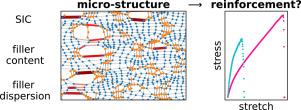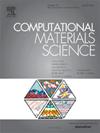A mesoscopic computer model for reinforcement in filled and strain-crystallizing elastomer networks
IF 3.1
3区 材料科学
Q2 MATERIALS SCIENCE, MULTIDISCIPLINARY
引用次数: 0
Abstract
To study reinforcement, particularly in Natural Rubber, a model developed for filled rubber is integrated into a model for elastomers which involves strain-induced crystallization (SIC). The combined model considers both the structures of strain-induced crystallites and the filler morphology in the rubber matrix. The focus here is on the investigation of 2D-networks. At small deformations, the Payne effect can be observed for model networks containing a fraction of filler larger than the percolation threshold. It is caused by breaking of filler-filler bonds. At larger deformations, the stress of both crystallizing and non-crystallizing model networks is amplified by the inclusion of filler. The effect is enhanced if the filler is finely dispersed. The combined model is extended by a critical free energy density for the rupture of model polymer chains. This rupture criterion determines whether the tensile strength and elongation at break of crystallizing or non-crystallizing networks are higher. Despite discrepancies for unfilled networks, the behavior of the tensile strength dependent on filler content approaches the experimental observations for finely dispersed filler.

填充和应变结晶弹性体网络加固的中观计算机模型
为了研究补强,尤其是天然橡胶的补强,我们将针对填充橡胶开发的模型与涉及应变诱导结晶(SIC)的弹性体模型相结合。该组合模型同时考虑了橡胶基体中应变诱导结晶的结构和填充物形态。这里的重点是研究二维网络。在小变形情况下,对于含有大于渗流阈值的填充物的模型网络,可以观察到佩恩效应。这是由于填料-填料键断裂造成的。在变形较大时,结晶和非结晶模型网络的应力都会因填料的加入而放大。如果填料分散得很细,这种效应就会增强。模型聚合物链断裂的临界自由能密度扩展了组合模型。该断裂标准决定了结晶网络和非结晶网络的拉伸强度和断裂伸长率是否更高。尽管未填充网络存在差异,但拉伸强度与填充物含量的关系接近于精细分散填充物的实验观察结果。
本文章由计算机程序翻译,如有差异,请以英文原文为准。
求助全文
约1分钟内获得全文
求助全文
来源期刊

Computational Materials Science
工程技术-材料科学:综合
CiteScore
6.50
自引率
6.10%
发文量
665
审稿时长
26 days
期刊介绍:
The goal of Computational Materials Science is to report on results that provide new or unique insights into, or significantly expand our understanding of, the properties of materials or phenomena associated with their design, synthesis, processing, characterization, and utilization. To be relevant to the journal, the results should be applied or applicable to specific material systems that are discussed within the submission.
 求助内容:
求助内容: 应助结果提醒方式:
应助结果提醒方式:


